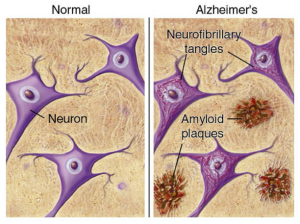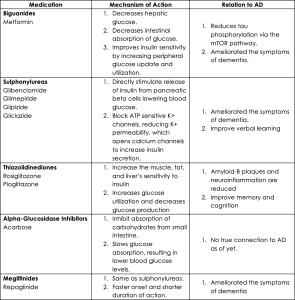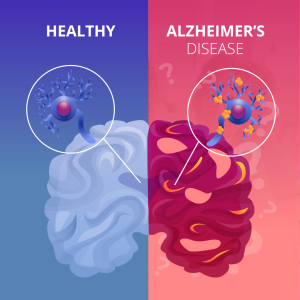Alzheimer’s and The Brain:
Alzheimer’s is a neurodegenerative disease that results in memory loss and decreased cognitive function. It begins by attacking the area of the brain associated with learning, but when it advances through the brain it leads to many other symptoms such as disorientation, mood changes, and difficulty speaking just to name a few.
Alzheimer’s disease starts in the cells of the brain. The brain has almost 100 billion neurons that work together to communicate certain needs. Just like corporate America, there are groups of cells that do specific jobs and work in their own offices, but when something goes wrong in one office it causes a growing problem in many other offices of the brain as well. Therefore, once there is too much damage the cells eventually die causing irreversible changes in the brain.
The Culprits:
There are two abnormal structures associated with Alzheimer’s that have been found in the brain.
- Amyloid-Beta Plaques: which are deposits of a protein that build up in the
 spaces between neurons
spaces between neurons - Tangles: which are twisted fibers of a protein called Tau that build up inside of cells.
These abnormalities have been shown to block communication among the neurons, which eventually leads to cell death.
I Thought Insulin Was Only In Type 2 Diabetes?
Insulin has been shown to play a major role in Alzheimer’s disease. Now, you might be thinking that insulin is only associated with Diabetes but let me tell you the connection between insulin, diabetes, and Alzheimer’s disease.
Insulin is a hormone that regulates glucose metabolism. Insulin is a neuroprotective agent that acts against cell death, but when the body becomes resistant to insulin (just like it does in Type 2 Diabetes) many things can go wrong.
Insulin resistance (IR) degrades the insulin-degrading enzyme (IDE) which then doesn’t allow for the removal of amyloid-beta plaques. IR also activates the MAPK signaling pathway, which will activate the production of amyloid-beta plaques. Additionally, IR decreases a pathway called PI3K/Akt, and this leads to the phosphorylation of the Tau protein causing more tangles to form in the neurons.
Both Alzheimer’s and Type 2 Diabetes have a connection with insulin, which could mean that people with Type 2 Diabetes have a higher chance at developing Alzheimer’s because of insulin resistance, but how do we try and prevent this?
For years, trying to treat Alzheimer’s was an enigma that puzzled many researchers, doctors, and families but more recently there have been updates to the treatment of Alzheimer’s by using oral hypoglycemics.
Why Oral Hypoglycemics?
Oral hypoglycemics are a group of drugs used to help reduce the amount of sugar present in the blood by altering the levels of insulin. They are not insulin, but they act like insulin to stimulate the pancreas and the liver. These types of drugs are usually used to treat type 2 diabetes but research has been done to show that they also help reduce the symptoms of Alzheimer’s disease. I have attached a table including some oral hypoglycemics and their role in treating the symptoms that come with Alzheimer’s. 
